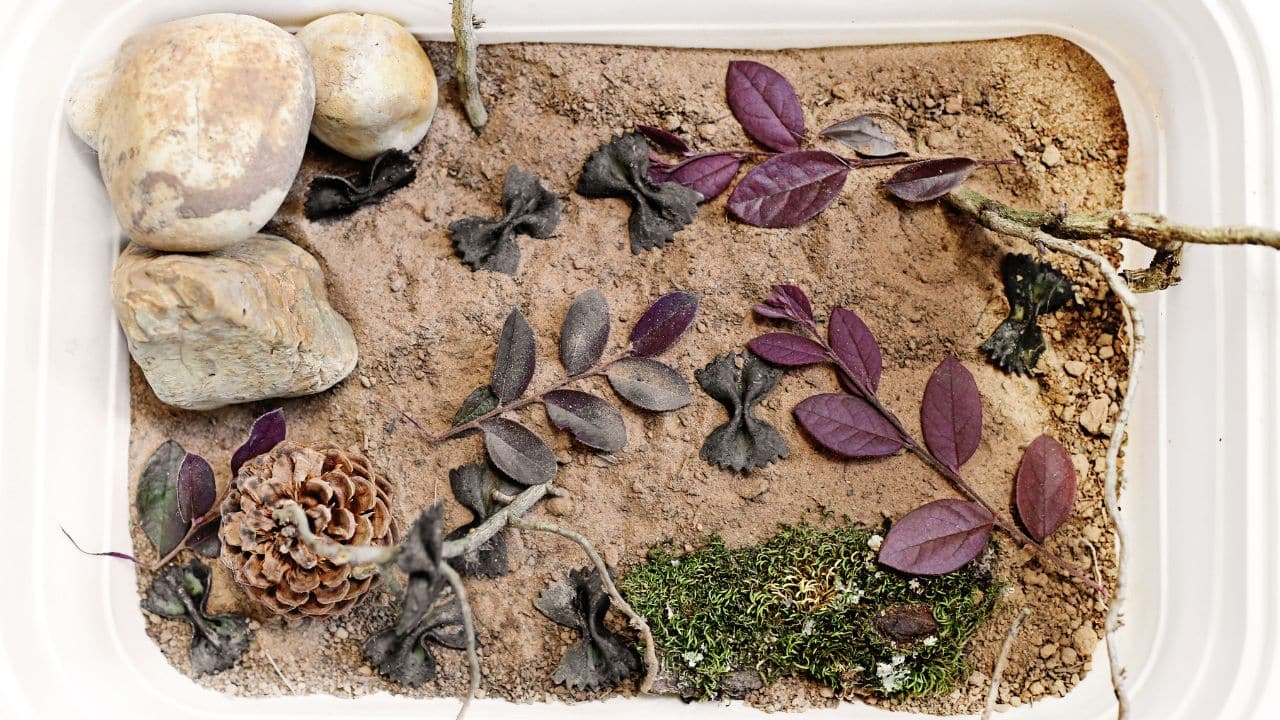Looking for a hands-on, slightly spooky, and totally nature-inspired sensory activity?
This bat cave bin is the perfect blend of creepy-crawly and creative play. With dirt, leaves, rocks, and a few painted pasta bats, it’s an invitation to explore the forest floor and the creatures who call it home.
But here’s what I love about it…this isn’t just a Halloween craft. It’s a simple way to introduce kids to one of nature’s most misunderstood animals: bats.
Why Bats? Fun Facts for Curious Kids

Before you dive into the dirt, take a second to share a few cool facts about bats. It sets the scene and gives kids context for the play that follows.
- Bats are the only mammals that can truly fly.
- Many bats are nocturnal and sleep upside down during the day.
- Some bats eat fruit and help pollinate plants—others eat insects like mosquitoes.
- Bats use echolocation to find their way in the dark—like built-in sonar!
When I create sensory bins like this, I love pairing the mess with a little meaning. It’s a chance to get dirty and learn something new. That’s why I like weaving in nature facts and giving kids space to ask questions or imagine life as a little bat in a big, wild cave.
Supplies Needed

Before you dive into building your cave, gather these nature-based and craft-friendly items to create a sensory world that’s equal parts earthy and eerie.
- Clean dirt or potting soil (for the base)
- Medium and small rocks (to form the cave)
- Sticks (tree trunks or fallen branches)
- Leaves (real or fake work great)
- Pinecones (tiny forest details)
- Bowtie pasta
- Black paint
- Hand sanitizer (helps the paint stick)
- Gallon-size zip-top bag
How to Dye the Bowtie Pasta Bats

These little black bowtie bats are the stars of the show. Here’s how to transform plain pasta into spooky cave dwellers.
- Place dry bowtie pasta in a gallon zip-top bag.
- Add a generous squirt of black paint and a small squirt of hand sanitizer.
- Seal the bag and shake it up until the pasta is evenly coated.
- Spread the pasta out on wax paper or a tray and let it dry completely—this usually takes a few hours.
Once dry, the bowtie shapes look just like little bats with their wings spread out, ready to take flight.
How to Set Up the Sensory Bin

Now it’s time to turn that bin into a moody forest scene. Set it up in layers to invite open-ended play.
- Pour dirt into the bottom of the bin to mimic the forest ground.
- Build your bat cave by stacking medium-sized rocks to form a small hollow or cave-like structure.
- Add sticks, placing them upright like bare trees or fallen like logs.
- Scatter leaves and pinecones around the bin to give it a true woodland floor vibe.
- Place your bats: hide them in the cave, perch them on sticks, and let a few “fly” across the dirt surface for added drama.
Optional: Add a flashlight for extra fun—kids can shine it into the cave to “spot” the bats like real nighttime explorers.
How Kids Can Play

This bin isn’t just about looking good—it’s packed with possibilities for learning and imagination. Encourage your child to explore the scene in their own way, or try some of these ideas:
- Pretend play: Fly bats in and out of the cave, create nighttime adventures, or make up stories about forest animals.
- Build and rebuild: Rearrange the cave structure or “plant” trees in new spots.
- Hide and seek: Bury pinecones or bats in the dirt and have your child dig them up.
- Sort and count: Group leaves, pinecones, and bats by size or color. Count how many of each are in the bin.
- Story prompts: “Where do these bats go during the day?” or “What happens when a big storm comes to the cave?”
Conversation Tips for Parents:
- “What do you think bats do in the cave all day?”
- “Can you build a bigger cave so more bats can fit?”
- “Where should the baby bats sleep?”
- “What other animals might live in this forest?”
Give your child space to lead, but sprinkle in thoughtful prompts to expand the play and build language and critical thinking skills.
Benefits of This Activity

This sensory bin hits multiple developmental targets at once, all while your child is having fun:
- Fine Motor Skills: Pinching bats, stacking rocks, and placing leaves works those little fingers.
- Imaginative Play: Building scenes and inventing stories taps into creativity and emotional expression.
- Sensory Exploration: Dirt, leaves, pinecones, and pasta offer a range of textures and smells.
- STEM Thinking: Designing a stable cave requires spatial planning and problem-solving.
- Nature Connection: Promotes curiosity about wildlife and the natural world through play.
Frequently Asked Questions

Can I use something other than dirt?
Yes! Kinetic sand, coffee grounds, or shredded paper can be used as a cleaner or indoor-friendly option.
Is the pasta safe to touch after painting?
Once dry, the pasta is safe for sensory play. Make sure to use non-toxic paint and keep it away from mouths—this activity is best for kids who are past the mouthing stage.
What age is this best for?
This bin is ideal for ages 3 and up. Toddlers can enjoy it with supervision, especially if you skip small choking hazards or substitute safer materials.

Leave a Reply